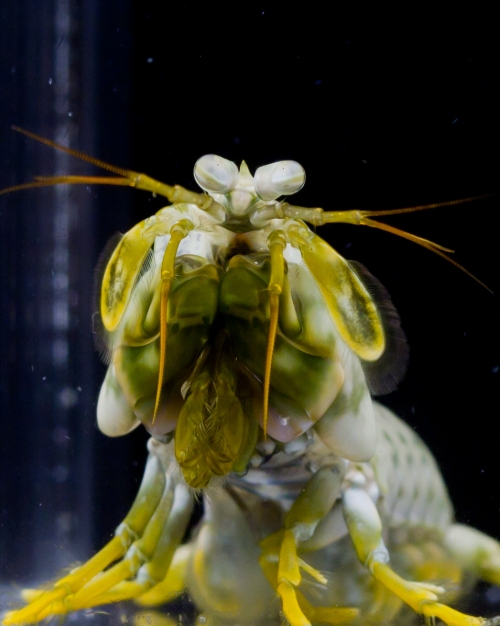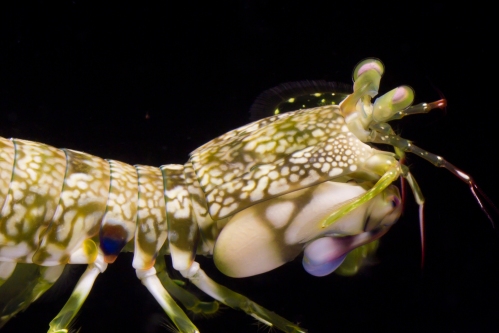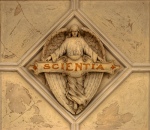Today, I took my first shot at fo-macro photography using a 50mm reverse-mounted lens. I think I had a little success despite obvious issues with the built in flash. I like this shot of a damselfly, Argia apicalis (Zygoptera), munching on some sort of bug.
Archive for the 'Photography' Category
Is there something in my teeth?
Published July 20, 2010 Photography , Zygoptera (Damselflies) 3 CommentsTags: Argia, Damselfly
Gonodactylus chiragra (Gonodactyloidea)
Published July 9, 2010 Photography , Stomatopods (Mantis Shrimp) 13 CommentsTags: Biomechanics, Mantis Shrimp, Stomatopod, Strength
In contrast to the pretty and placid G. playtsoma, today I have a photo and video of one of the meanest mantis shrimps I have encountered. Gonodactylus chiragra occurs in the same intertidal reef flats as G. playtsoma, but its temperament is the polar opposite. It hits hard and often.
Its coloration is a mottled brownish-yellow-green on creme; except for bright orange and yellow accents on the antennae, mouthparts, and walking legs.
Here is a quick video of G. chiragra, whalloping the wall of its aquarium; attempting to hammer my finger (off-screen). It plays at regular speed and then at one-tenth speed (the slow-mo is much more impressive and/or comical, in my opinion).
If you want to know more about the astounding stomatopod strike, check out my previous article: Why Stomatopods are Awesome, I: Super Strength.
This was my first attempt at editing together a video, and I will hopefully have more content like this in the future.
Gonodactylus platysoma (Gonodactyloidea)
Published July 7, 2010 Photography , Stomatopods (Mantis Shrimp) 9 CommentsTags: Fluorescence, Gonodactylus, Mantis Shrimp, Stomatopod
I first saw this species of stomatopod in the field this year. They are really beautiful animals, with subtle but vibrant color accents on their dactyls, antennae, eyes, and on the edges of some of their somites (body segments). This individual is about 72 mm in length, and the species seems to be fairly docile (for stomatopods).
This animal also has very beautiful fluorescent patterns on its body:
I talked previously about fluorescence in stomatopods here. However, I don’t know if the patterns on G. platysoma are used to amplify any particular signals. These animals live in shallow water and would have less use for fluorescent signal amplification.
Some cool panoramas from Lizard Island
Published June 30, 2010 Photography 2 CommentsTags: Lizard Island, Photoshop
I had a little fun with Photoshop, stitching together some photos that I took at Lizard island. I didn’t originally intend to turn these photos into panoramas, but I’m fairly pleased with the results. Once again, Photoshop is witchcraft.

The lizard Island Group lagoon, taken from the lizard neck peninsula of lizard Island. From left to right: Bird Islet, South Island, and Palfrey Island protect the lagoon.

This is the view back at Watsons Bay from the start of the ridge leading up to Cook's Look (visible in the last photo). Watsons Bay is adjacent to the ludicrously expensive resort. It is an Australian National Park area and provides a place to anchor for pleasure yachties.

A higher altitude view of Watsons Bay from the Cook's Look ridge path. South and Palfrey Islands are coming into view in the background.

Watsons Bay and Cook's Look hill, taken from an outcrop near the resort. The Cook's Look trail starts at the beach of Watsons Bay, climbs to the left to mount the ridge, and then continues along the ridge to the summit. The 395 meter hill is so named because Captain James Cook climbed it in order to plot a course out of the maze of reefs in the area in 1770.
Following my first proof-of concept attempt at UV photography yesterday, I went out around campus again today with a tripod and remote. I got some much better shots of flowers and the campus. This time I’ve left the photos exactly as they came off the camera. Near violet UV records in the blue channel, and deeper UV in the red channel (For reference the dandelion outer ring has a reflectance peak around 350 nm, recorded here in the red channel).

Here is my very first attempt at ultraviolet photography. The was taken with a Nikon D1H with a UV Nikkor 105 lens and filter glass for blocking visible and infrared light (400 nm and up). I took this with a half second exposure and no tripod and remote, so it is a bit blurry. The dandelion, like many flowers, has a distinct UV ring pattern that is visible to many insect pollinators. Here, reflected UV light is false colored white.
I really wish I had gotten a more stable shot since there is also an ant visiting the center of the flower.
Adobe Photoshop CS5: Now with witchcraft!
Published April 15, 2010 Photography 11 CommentsTags: Photoshop
The new version of the indispensable Photoshop image editor came out a couple days ago, and includes an unbelievable feature called Content Aware Fill. According to Adobe:
We have developed interactive image editing tools using a new randomized algorithm for quickly finding approximate nearest neighbor matches between image patches.
Essentially it removes unwanted items from an image instantly and seamlessly. Alterations that used to take a skilled Photoshop user hours to preform are completed in seconds with almost no competence required. Watch these videos; and if image editing is a time consuming part of your work, prepare to pick your jaw up off the floor.
This one starts off with minor tweaks, like removing lens flare and bits of trash from a scene, but skip to the middle or so to see the ridiculously awesome stuff.
This video shows how great this is for easily toughing up images.
There is a better explanation of how Content Aware Fill works, here. I prefer to think it uses witchcraft or is the rudimentary self-aware beginnings of Skynet. Run for it, Sarah Connor.
I am coming close to the precipice of my first DSLR camera purchase. Currently, I am considering a couple mid to upper-entry level cameras from Cannon and Nikon. The hope is to get a decent body with the kit lens to practice with for now, and then start trying to save for better glass. The three top contenders at the moment are:
Mostly, people have told me that I can’t go wrong with most Cannon and Nikon bodies within a similar price range. With that in mind, I am leaning heavily towards the 550D which has the added perk of 30fps 1080p video recording. I also really like the menu layout and controls on this camera. Is there any serious photography drawback to the 550D versus the Nikon, which does not have the 1080p video recording?
Also, I know a lot of my readers are spectacular macro photographers, and that is something I really want to get into at some point when I can afford the right lens and flash. Any advice you can offer would be massively appreciated. 
Neogonodactylus bredini
Published April 2, 2010 Photography , Stomatopods (Mantis Shrimp) 4 CommentsTags: Mantis Shrimp, Neogonodactylus
I haven’t had much time to write this week on account of wanting to graduate someday. Here is one of the animals that I’m working on at the moment.
N. bredini is the easiest mantis shrimp to find on the east coast since they commonly hitch-hike on reef rubble, cultured in Florida for the aquarium trade. The photo above shows the ‘smasher’ raptorial appendage nicely, as well as the black pseudo-pupil (the facets of the eye that are directly facing the camera). These guys come in a bunch of different color morphs including the rusty color above, green, and grey mottled.
I’m trying to improve my photography skills, but the old Olympus C-5050 I’m using isn’t cutting it any more. It’s no fun trying to manually focus on a moving critter using a 1.8″ 110,000-pixel screen.
_________________________
Edit: Correction, this animal is actually N. wennerae. This species is physically indistinguishable from N. bredini. The only reliable determinant other than genetics is habitat depth.

Dew covered insects
Published March 30, 2010 Hexapods , Photography 1 CommentTags: Dragonfly, Macro
Miroslaw Swietek takes amazing photos of dew covered insects in the early-morning woods. The insects remain mostly immobile during the night and collect water droplets all over their bodies. Take a look at his beautiful photos here and here.

Water droplet covered dragon fly. Photo: Miroslaw Swietek
Via i09.



























